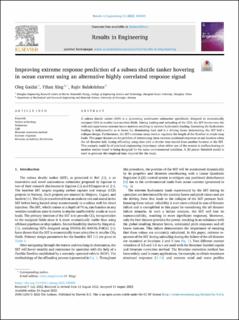| dc.contributor.author | Gaidai, Oleg | |
| dc.contributor.author | Xing, Yihan | |
| dc.contributor.author | Balakrishna, Rajiv | |
| dc.date.accessioned | 2022-09-12T07:30:27Z | |
| dc.date.available | 2022-09-12T07:30:27Z | |
| dc.date.created | 2022-08-13T23:03:18Z | |
| dc.date.issued | 2022-09-02 | |
| dc.identifier.citation | Gaidai, O., Xing, Y., & Balakrishna, R. (2022). Improving extreme response prediction of a subsea shuttle tanker hovering in ocean current using an alternative highly correlated response signal. Results in Engineering, 100593. | en_US |
| dc.identifier.issn | 2590-1230 | |
| dc.identifier.uri | https://hdl.handle.net/11250/3017084 | |
| dc.description.abstract | A subsea shuttle tanker (SST) is a pioneering underwater submarine specifically designed to economically transport CO2 to smaller hydrocarbon fields. During loading and unloading of the CO2, the SST hovers over the well and experiences extreme heave motions resulting in extreme hydrostatic loading. Sustaining the hydrostatic loading is indispensable as it forms the dominating load and is a driving factor determining the SST hull's collapse design. Furthermore, the SST's extreme surge motion regulates the length of the flowline to evade snap loads. This paper focuses on the problem of determining these extreme positional responses at one location when the aft thruster fails during offloading using data with a shorter time record from another location at the SST. This scenario could be of practical engineering importance when either one of the sensors is malfunctioning or another similar vessel is being designed for the same environmental condition. A 2D planar Simulink model is used to generate the empirical data required for the study. | en_US |
| dc.language.iso | eng | en_US |
| dc.publisher | Elsevier | en_US |
| dc.rights | Navngivelse 4.0 Internasjonal | * |
| dc.rights.uri | http://creativecommons.org/licenses/by/4.0/deed.no | * |
| dc.subject | subsea technology | en_US |
| dc.subject | submarine | en_US |
| dc.subject | LQR | en_US |
| dc.subject | bivariate correction method | en_US |
| dc.subject | extreme responses | en_US |
| dc.subject | bivariate probability distribution | en_US |
| dc.title | Improving extreme response prediction of a subsea shuttle tanker hovering in ocean current using an alternative highly correlated response signal | en_US |
| dc.type | Journal article | en_US |
| dc.type | Peer reviewed | en_US |
| dc.description.version | publishedVersion | en_US |
| dc.rights.holder | The authors | en_US |
| dc.subject.nsi | VDP::Technology: 500::Materials science and engineering: 520 | en_US |
| dc.source.pagenumber | 1-9 | en_US |
| dc.source.journal | Results in Engineering (RINENG) | en_US |
| dc.identifier.doi | 10.1016/j.rineng.2022.100593 | |
| dc.identifier.cristin | 2042822 | |
| dc.source.articlenumber | 100593 | en_US |
| cristin.ispublished | true | |
| cristin.fulltext | postprint | |
| cristin.fulltext | original | |
| cristin.qualitycode | 1 | |

